Cite this document
(“Crime Prevention, Disorder and Community Safety (Criminolgy) Essay”, n.d.)
Retrieved from https://studentshare.org/environmental-studies/1421770-crime-prevention-disorder-and-community-safety
Retrieved from https://studentshare.org/environmental-studies/1421770-crime-prevention-disorder-and-community-safety
(Crime Prevention, Disorder and Community Safety (Criminolgy) Essay)
https://studentshare.org/environmental-studies/1421770-crime-prevention-disorder-and-community-safety.
https://studentshare.org/environmental-studies/1421770-crime-prevention-disorder-and-community-safety.
“Crime Prevention, Disorder and Community Safety (Criminolgy) Essay”, n.d. https://studentshare.org/environmental-studies/1421770-crime-prevention-disorder-and-community-safety.


